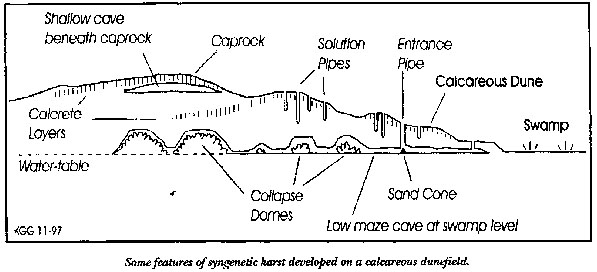As Kent's deadline drew nigh yet again I received an email from Ken Grimes offering a GUEST ANDYSEZ! Such an offer is absolutely unprecedented and I wish there were more distinguished Ladies and Gentlemen around of the calibre, competence, scholarship, charm, wit and all-round good chapedness like the Lovely Lady Louisa and her consort, Professor Grimsley.
The last ANDYSEZ discussed some general attributes of limestone and a way of turning concrete into limestone again. Professor Grimsley's valued, and valuable, contribution to the field discusses a particular suite of karst landforms which, whilst not restricted to Australia, have perhaps their best expression here. He also discusses some aspects of the lithology of the rock which hosts syngenetic karst.
Whilst this is not quite what I was going to write for this ANDYSEZ it does fit the general theme that I was going to pursue over the next few issues of the Journal. The next edition will explore limestones more generally; that will be followed by another GUEST ANDYSEZ from Chris Sharples and Ian Houshold on karst in magnesite (note the deadlines, Ian and Chris).
SYNGENETIC KARST
by Professor Grimsley (aka Ken Grimes)
Syngenetic karst is a special feature of the soft calcareous dune limestones found in the coastal regions of southern and western Australia.
The dune limestones are a series of calcareous sand ridges which formed as dunes along the present or prior coastlines during the Quaternary (the last 2 million years, and pretty young by geological standards). The dune ridges are now partly consolidated calcarenites: that is, sandy limestones in which the sand grains are mainly fragments of marine shells that grew in the shallow seas, were washed up onto the beach, and then blown inland. The dune limestone commonly has well-developed bedding. This includes inclined "cross-beds" that trace the series of slip-off slopes of the old dune as it moved forward, and occasionally flatter beds that might represent the associated beach sediments.
In these calcareous Quaternary dunes some karst features are "syngenetic", in that they have developed at the same time as the sand was being cemented into a rock. The term was coined by Joe Jennings in 1968, based partly on observations made by Lex Bastian in WA and Alan Hill in SA. The unconsolidated calcareous sand of the coastal dunefields is converted to limestone gradually by solution and redeposition of calcium carbonate by percolating water. This initially produces a caprock or calcrete layer which is capable of supporting the roof of a shallow cave. The downward percolating water also dissolves vertical solution pipes, and simultaneously cements the surrounding sand. It then continues to carry dissolved calcium carbonate downward to slowly cement and strengthen the deeper sands. Simultaneously, enhanced mixing corrosion (see ANDYSEZ Number 3) occurs where percolation water meets the water table - typically at the level of an adjacent swampy plain. Initially the soft sand subsides immediately and no cavities remain, but once the rock is sufficiently hardened to support a roof, the solution at the water table results in the development of horizontal caves at that level.
Because the "rock" has limited strength, it collapses easily and breakdown is extensive, particularly in the early stages. As the rock becomes harder, and solution continues at the base of the cave (commonly beneath the rubble piles) larger chambers can form. In some West Australian cave areas, the water flow is concentrated into streams by the surface of an impermeable basement and linear stream caves result.
The main characteristics of syngenetic karst are the development of a cemented (calcreted) caprock near the surface, of vertical solution pipes, and of low, wide, horizontal maze caves either beneath the caprock or at the level of the adjoining swampy plains (see Figure). Where the water movement has been concentrated into underground streams, as in West Australia, linear stream caves may develop. Breakdown is extensive; in many cave systems much of the original solutional system at the water-table is now supplanted by collapse domes - typically with the rubble floor rising and falling in parallel with the roof, leaving only a narrow gap for cavers to travel through. Particularly good examples of this can be seen at the Kelly Hill Caves on Kangaroo Island. Re-cemented breccias are seen in the walls of some caves. Subsidence and collapse dolines occur on the surface. In places mass subsidence can generate a chaotic surface of tumbled blocks and fissures.

Solution pipes are one of the most distinctive features of syngenetic karst. They are vertical cylindrical tubes with case-hardened walls, typically 0.5 to 1 m in diameter, which can penetrate down from the surface as far as 20 metres into the soft limestone. The pipes may contain roots (and root growth may have occurred hand-in-hand with solution of the pipe). They occur as isolated features, or in clusters with spacings as close as a metre or so. Many of the caves are entered via such pipes.
Syngenetic karst development is typical of the Quaternary dune calcarenites; however, the Tertiary limestone at Mount Gambier is also a relatively soft porous limestone, and consequently it shows some of the features of syngenetic karst, in particular the development of solution pipes and calcreted caprocks.